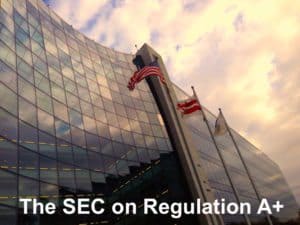 Regulation A+, created by Title IV of the JOBS Act, has been lauded by many as a missing step in the capital ladder for smaller firms in need of funding. The updated securities exemption became effective on June 19, 2015, and since that time a growing number of issuers have utilized the rule to raise money – some using crowdfunding platforms. Several weeks back, writing for the SEC Division of Economic and Risk Analysis (DERA), Anzhela Knyazeva provided a reflection and review entitled “Regulation A+: What Do We Know So Far” on Reg A+ since the rule became actionable. As the SEC is the repository of all securities filings, one anticipates the data on Reg A+ is about as good as it gets. The paper shared multiple data points, including:
Regulation A+, created by Title IV of the JOBS Act, has been lauded by many as a missing step in the capital ladder for smaller firms in need of funding. The updated securities exemption became effective on June 19, 2015, and since that time a growing number of issuers have utilized the rule to raise money – some using crowdfunding platforms. Several weeks back, writing for the SEC Division of Economic and Risk Analysis (DERA), Anzhela Knyazeva provided a reflection and review entitled “Regulation A+: What Do We Know So Far” on Reg A+ since the rule became actionable. As the SEC is the repository of all securities filings, one anticipates the data on Reg A+ is about as good as it gets. The paper shared multiple data points, including:
- As of October 31, 2016, issuers have publicly filed offering statements for 147 Regulation A+ offerings, seeking up to approximately $2.6 billion in financing.
- Approximately 81 offerings seeking around $1.5 billion have been qualified by the Commission.
- About $190 million has been reported raised during that period (although this likely understates the true amount raised due to reporting timeframes).
- Issuers are using both Tier 1 and Tier 2, but Tier 2 offerings were more common among qualified offerings, accounting for 60% of qualified offerings.
- The average issuer was seeking up to approximately $18 million.
- Companies mainly offered equity, which accounted for over 85% of all offerings.
- The median time from initial public filing to qualification was 78 days
- Tier 2 offerings were associated with longer qualification times than Tier 1 offerings.
- The median legal cost was reported to be approximately $40,000 ($50,000) based on all filings (qualified offerings).
- The median audit cost was reported as approximately $15,000 for filed and qualified offerings.
- The median intermediary fee, where reported, was about $150,000 among all offerings and approximately $100,000 among qualified offerings.
- The most offerings were by issuers with a business location in California. Other common issuer locations were DC, Virginia, Florida, and Texas, consistent with a relatively high number of businesses, including small businesses and startups, in those locations.
- Finance, insurance, and real estate sector accounted for the largest number of offerings and total amount offered across issuers. Approximately 37% of filings based on number and 50% of the aggregate offer size were from this sector.
- The top 5 two-digit SIC industries included real estate, holding and other investment offices, and depository and non-depository credit institutions. Business services were also among top 5 industries.
- Based on all filings with available data, the median issuer had no cash, property, plants and equipment (PP&E), long-term debt, revenue, or net income.
- The median issuer in a qualified offering had approximately $0.05 million in cash; zero PP&E; no long-term debt; no revenues; and no net income.
 There is no requirement for an issuer to utilize an intermediary yet several crowdfunding platforms and some broker-dealers are participating in the issuing process. About 38% of all offerings and 36% of qualified offerings have used intermediaries. Knyazeva believes that “limited intermediary participation might pose the greatest hurdles to capital raising for small first-time issuers that are relatively less well known to prospective investors.”
There is no requirement for an issuer to utilize an intermediary yet several crowdfunding platforms and some broker-dealers are participating in the issuing process. About 38% of all offerings and 36% of qualified offerings have used intermediaries. Knyazeva believes that “limited intermediary participation might pose the greatest hurdles to capital raising for small first-time issuers that are relatively less well known to prospective investors.”
The entry of underwriters into the Reg A+ market may boost the credibility of issuers and may be important for future growth. This is especially true for smaller firms with limited history and thus investor trust. A credible track record may create positive feedback and further attract issuers and intermediaries.
The present pool of companies filing a Reg A+ offer is largely comprised of smaller companies that may be challenged to get a bank loan or other financing on favorable terms.
Knyazeva points to the need to study over time the success rate of issuers;
“To the extent that issuers in this market share similarities with other startups and small issuers, it is likely that issuers will have relatively high failure rates. For issuers that successfully execute their business plans and begin to generate revenue, it would be useful to examine the rates of survival and exit and the occurrence of any follow-on corporate restructuring.”
While noting this sector of finance was still very much and evolving space, Knyazeva asks the question as to where Reg A+ will emerge on the continuum of capital raising methods available to small issuers. Clearly, the SEC reinvigorated moribund old Reg A when they changed the rules. But in her opinion, it is unclear as to how relevant early data will be in predicting the future growth of the Reg A+ market.
See the research below.

